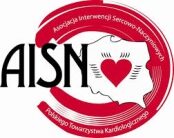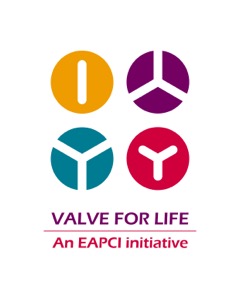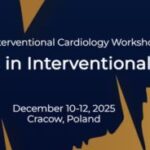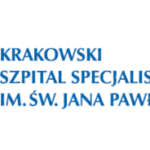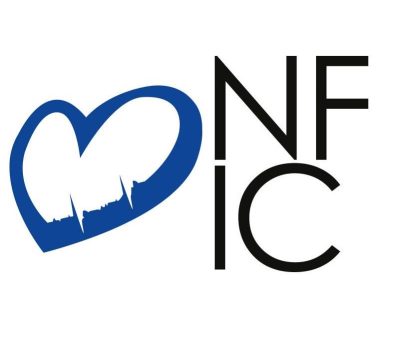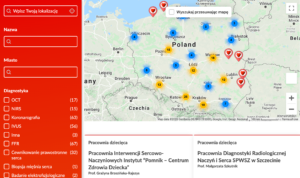Coronary angioplasty and percutaneous coronary angioplasty procedures in Poland in 1993-2004. Analysis from the perspective of the chairmen of the Invasive Cardiology Section of the Polish Society of Cardiology
Witold Rużyłło, Robert J. Gil, Adam Witkowski. Post Kardiol Int 2005, 1: 3-7
Diagnostic procedures of invasive cardiology (including right and left heart catheterization, angiocardiography and coronary angiography) were gradually introduced in Poland in the 1950s, 60s and 70s. However, the dynamic development of this clinical area began with the introduction of percutaneous coronary angioplasty procedures (PCI). The first PCI procedure was performed in Poland in 1981 (W. Rużyłło), and after two years these procedures were started routinely. Their number was small in the first years. The threshold of 1,000 PCI procedures was exceeded for the first time in 1989, while the barrier of 5,000 was overcome eight years later in 1997. Of course, the increase in the number of PCI was accompanied by a rise in the number of coronary angiography, with the percentage of patients undergoing PCI increased each year in the patients who underwent coronary angiography.
This gradual increase in the number of coronary angiography and PCI was, of course, associated with the formation of consecutive centers of interventional cardiology and the increase in the number of people performing the above-mentioned procedures. These facts and the growing popularity of this field of medicine in the world caused that in the spring 1993 the idea of creating a new section of the Polish Cardiac Society (PCS), dealing with the issues of invasive cardiology, appeared. The founding meeting of the Invasive Cardiology Section was held on October 7, 1993 in Szczecin, during the 57th Scientific Conference of the PCS. 88 people were enrolled in the Section at that time. In 2004, in 65 cardioangiographic laboratories on 88 tables, 466 doctors performed diagnostic procedures, mainly coronary angiography; and among them, 349 physicians also performed PCI procedures. If we add 7 cath labs that perform interventional cardiology procedures for children and adolescents, we will get an impressive number of 72 cath labs and a huge potential of educated and highly trained people – doctors, nurses and technicians. Thanks to their intellectual and physical effort, the great progress in the field of interventional cardiology in Poland in the last 12 years was possible.
Since the successive presidents of the Invasive Cardiology Section of PTK, W. Rużyłło, R. J. Gil and A. Witkowski, had or have by nature the most broad view of the situation and problems related to the functioning of cardiac laboratories in the country, we considered it advisable to describe and analyze from our perspective the development of invasive diagnostics and PCI treatments in the years 1993-2004. Of course, we are well aware of the fact that the treatment of coronary artery disease is not the only field of activity of interventional cardiologists. A whole range of other procedures, including congenital and acquired heart defects, peripheral and carotid artery stenosis are performed daily in our country. However, coronarography and PCI procedures are the core of our activity, they are our daily bread and certainly the most important field of activity. This is primarily related to interventional treatment of acute coronary syndromes (ACS), including acute ST-elevation myocardial infarction (STEMI). The launch of a network of cardioangiography laboratories in Poland, where a 24-hour duty for patients with acute myocardial infarction is certainly one of the greatest, if not the greatest, successes of interventional cardiology in Poland in the last few years. In conclusion, we would like to present the initiatives taken by the Management Boards of the Invasive Cardiology Section of PTK, which, in our opinion, have found expression and continuation in concrete and practical actions, programmes and trainings, as well as matters which, unfortunately, have not been implemented. The names of the chairpersons and members of the Boards of the Invasive Cardiology Section of the PTK in 1993-2004 are presented in Table 1.
The development of centers of interventional cardiology, coronary angiography and coronary angioplasty procedures in 1993-2004
As mentioned above, in 1989, just over one thousand PCI procedures were performed in Poland. The truly dynamic development of coronary angiography and PCI procedures began in 1996, which was also associated with the rapid formation of new cath labs (33 in 1996), created as the part of the National Program for the Protection of the Heart. The fact of the increased availability of coronary stents probably also had an impact (15% in 1996). The percentage of treatment with stent (stents) systematically increased, which reflected global trends and in 2004 reached 83% in relation to all performed PCI procedures. In 2004, coronary angiography and coronary angioplasty were performed in 65 centers, and their number reached 120 667 and 58 105, respectively. This means that in 12 years (1993-2004) a huge quantum leap took place; the number of coronary angiography increased 5-fold, and the number of PCI procedures almost 12-fold! In relative numbers, this gives 3,175 coronary angiography per million inhabitants and 1,529 PCI procedures per one million inhabitants, which places Poland slightly above the European average. In the years 2003-2005, the formation of new centers of intervention cardiology and the continuation of existing work by financing the purchase of new angiographic devices was possible thanks to the National Program for the Prevention and Treatment of Cardiovascular Diseases POLKARD 2003-2005. The program was to be continued in 2006-2008, which raised hopes for further development of interventional cardiology.
We should mention innovative methods and techniques that were introduced in interventional cardiology in the treatment of ischemic heart disease, such as various types of atherectomy, brachytherapy, drug-eluting stents, angiogenesis or stem cell use in patients after acute myocardial infarction and dedifferentiated skeletal muscle cells in patients with ischemic cardiomyopathy. Some of them have already been discontinued for various reasons (atherectomy, brachytherapy), some are constantly in the clinical trial phase (angiogenesis and cell therapy). Drug eluting stents (drug-eluting stents, DES), rapamycin or paclitaxel, unfortunately, are implanted in a far too low percentage of treatments (4.4% in 2004). It is associated undoubtedly with the high price of these devices, which even taking into account its significant reduction in the last year gives the price to the price of conventional stent as 5:1. This matter is important due to the indisputable benefits that patients obtain after DES implantation and requires further discussions and negotiations with the National Health Fund and the Ministry of Health.
Interventional treatment of acute coronary syndromes
The introduction of a nationwide program for the interventional treatment of ACS funded by the National Health Fund is considered the greatest success of Polish cardiology in general and interventional cardiology in particular in the last 4 years. The number of ACS can be estimated in Poland at 140,000 cases per year, including STEMI – 50,000, acute myocardial infarction without persistent elevation of the ST segment (NSTEMI) – 30,000, and unstable coronary disease – 60,000. In May 2004, the 24-hour haemodynamic service was performed by 50 centers, in which 25,773 PCI procedures were performed during the year in patients with STEMI, NSTEMI and unstable coronary disease. The vast majority of centers launched a 24-hour on-call duty in 2001 and in the following years. Some centers have launched their own treatment programs for patients with STEMI (e.g. assisted angioplasty), others focused on the shortest possible time of patient transport to the intervention cardiology center, for example, the development of telemedicine and skipping intermediate links during transport. The percentage of PCI procedures in patients with ACS has steadily increased since 2000 and in 2004 was 44.5% in relation to all coronary angioplasty procedures. On the one hand, it has an optimistic overtone – procedures are performed in those patients who need it most and undoubtedly benefit the most. However, on the other hand this extremely dynamic increase in percutaneous interventions in patients with ACS is one of the factors extending the waiting time for elective procedures, especially coronary angiography. We believe that coronary angiography and PCI procedures in patients with ACS, above all STEMI and NSTEMI of increased risk, should be unlimited, and their performance should not deplete the number of points allocated in a given center to other interventional cardiology procedures. The second important issue is the lack of financing by the National Health Fund supporting antiplatelet therapy for patients with ACS (except STEMI). The lack of the possibility of using small molecule inhibitors of the IIb / IIIa platelet receptor in patients with NSTEMI or chronic clopidogrel therapy is inconsistent with the recommendations of scientific societies, unfortunately, this is common in Poland due to the National Health Fund’s failure to include these medicines in the services catalog.
What important things were achieved in interventional cardiology in 1996-2004?
- Launch of a 24-hour haemodynamic on-call service in many centres in the country for patients with SCA (50 centres in May 2004).
- Establishment of new interventional cardiology centres - financed under the National Heart Protection Programme (Chairman - Prof. Z. Sadowski) and POLKARD 2003-2005 (Chairman - Prof. G. Opolski).
- Developed and published in 1999 (Folia Cardiologica 1999; 6 (supplement IV): IV-1 - IV-44) recommendations of the PTK Invasive Cardiology Section for diagnostic and therapeutic procedures. The recommendations in their modernised form will be published again in 2005.
- Development of rules for accreditation of cardioangiographic laboratories. Currently, 51 laboratories in Poland are accredited by PTK class A, B or C.
- Development of accreditation rules for cardioangiographic paediatrics laboratories. The rules have been approved by the General Board of PTK.
- Creation of the National Electronic Database of Interventional Cardiology Treatments. The protocol was developed by D. Dudek, R. J. Gil, J. Kubica, P. Maciejewski and A. Witkowski. The database was put into use for all hemodynamic laboratories in the country in 2001. This type of register allows to keep track of the number of individual interventional cardiology procedures and provides reliable annual reports.
- Training of adepts from newly established centers in coronarography and PCI treatments. The training programme was developed by the Board of the Invasive Cardiology Section of PTK and is financed under the POLKARD 2003-2005 programme. The first training started in 2004. We hope that it will continue in the following years.
- Neuroprotective stent implantation procedures for carotid arteries. Programme developed, among others, by the Invasive Cardiology Section of PTK and financed in 2004 and 2005 under the POLKARD 2003-2005 programme.
- Introduction of non-operational, transcutaneous closure of abnormal intra- and extra-cardiac connections, including PFO, ASD and Botalla cable.
- Coroczne warsztaty oficjalnie akredytowane przez Sekcję Kardiologii Inwazyjnej PTK: Warszawa, Zabrze, Kraków.
- Introduction of over 70 people to the Working Group on Interventional Cardiology (WG10) European Society of Cardiology. This should ensure an important voice of the Polish community in matters of interventional cardiology in the European Union.
What has not been achieved?
- Abolish the point limits for the treatment of patients with hepatitis B. This was the subject of the speech of the current Board of the Invasive Cardiology Section of PTK to the President of the National Health Fund and a senatorial appeal to the Minister of Health.
- Introduction to the NHF benefit catalogue of modern pharmacotherapy supporting PCI treatments in SCA: clopidogrel and small molecular weight platelet receptor inhibitors IIbIIIa.
- Better financing of drug release stents by the National Health Fund. In the catalogue for 2005, a multi-vascular angioplasty procedure with DES and conventional stents has been successfully included. This may lead to an increase in the use of DES in Poland this year.
- Introduction of an independent quality control of interventional procedures in Poland, conducted by the Invasive Cardiology Section of the PTK.
References
- Gil R, Witkowski A, Ruthenian W. Transcutaneous coronary angioplasty in Poland. History and present. Surgery of coronary vessels. Zembala M (ed.). PZWL, Warsaw 2002.
- W. Invasive cardiac diagnostics and interventional cardiology. History of cardiology in Poland against the background of world cardiology Kuch J, Śródka A (ed.). PWN, Warsaw 2004.
- Acute coronary syndrome. Invasive treatment in Poland in 2002. Rudaly W (ed.). Kardiol Pol 2003; 58, supplement IV.
- Poloński L, Gąsior M, Gierlotka M et al. Epidemiology, treatment and prognosis in acute coronary syndromes in Silesia. Results of the pilot stage of the national register of acute coronary syndromes - PL-ACS. Kardiol Pol 2005; 62 (supplement I): I-22-I-27.
